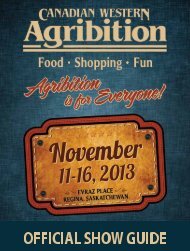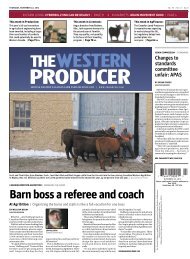Create successful ePaper yourself
Turn your PDF publications into a flip-book with our unique Google optimized e-Paper software.
EQUIPMENT | SEEDING<br />
BY RON LYSENG<br />
WINNIPEG BUREAU<br />
WAHPETON, N.D. — <strong>The</strong> Sunflower<br />
9800 Single Disc Drill introduced<br />
by Agco this summer is<br />
designed to work at speed.<br />
“If you don’t have the power to seed<br />
at a minimum of 5.5 m.p.h., then you<br />
need a bigger tractor,” said Mark<br />
Wyrick, global product manager for<br />
Agco-Amity.<br />
He said seven to nine m.p.h. is typical<br />
in fields where rocks are not an<br />
issue. When rocks are an issue, six<br />
m.p.h. is more appropriate.<br />
Seed bounce is not the problem a<br />
person might imagine when running<br />
at those speeds. Wyrick said the 9800,<br />
one of the heaviest drills on the market,<br />
is designed for higher speeds and<br />
to keep the openers at a constant<br />
depth.<br />
It’s called a single disc drill, but<br />
each trailing arm actually carries two<br />
sets of paired discs mounted six<br />
inches apart. <strong>The</strong>re’s a nine inch gap<br />
on the field surface, which is not disturbed,<br />
and then two more sets of<br />
paired discs on the next arm. <strong>The</strong> patent<br />
refers to it as opposing single<br />
discs.<br />
“I suppose you could also call it a<br />
paired row because the two discs<br />
work in conjunction with one another.<br />
<strong>The</strong>y depend on each other,” said<br />
Wyrick.<br />
“<strong>The</strong> discs fracture the soil and lift<br />
it. While the soil is lifted, the seed is<br />
placed into the soil. <strong>The</strong> soil then falls<br />
back over the seed row, preventing<br />
seed and fertilizer from bouncing<br />
out. Speed is an essential part of the<br />
plan.”<br />
Wyrick said the angle of the discs is<br />
critical in lifting the soil and letting it<br />
fall back over the seeds. <strong>The</strong> concept,<br />
which was engineered and patented<br />
in Australia, is aimed at dry regions<br />
where farmers want an absolute<br />
minimum of soil disturbance, he<br />
added.<br />
<strong>The</strong> disc on the left side throws soil<br />
to the right side, and a distinct line in<br />
the field delineates where the disc<br />
travelled. <strong>The</strong> field to the left of this<br />
disc is undisturbed.<br />
<strong>The</strong> same action is repeated with<br />
the disc on the right side throwing<br />
soil to the left. <strong>The</strong> field surface to the<br />
right, outside the seed zone, is left<br />
untouched.<br />
Amity Technology thought the drill<br />
would be a good fit for drier regions of<br />
North America.<br />
It bought the patents and now<br />
manufactures the drill in the Agco-<br />
Amity joint venture factory in Wahpeton,<br />
N.D.<br />
Amity field tested 25 units in 2008,<br />
fine tuning the geometry of the discs<br />
to suit heavy clay soil.<br />
<strong>The</strong> discs have what amounts to five<br />
degrees toe-out. <strong>The</strong> leading edges of<br />
the two discs at the nine o’clock position<br />
are farther apart than the trailing<br />
edges at the three o’clock position.<br />
<strong>The</strong> pair of discs are six inches<br />
apart, and their action creates a six<br />
inch wide cultivated seedbed for two<br />
rows of seed.<br />
<strong>The</strong> discs also have three degrees<br />
positive camber, so the bottoms of<br />
the discs at the six o’clock position are<br />
closer to each other in the soil than<br />
they are at the 12 o’clock position.<br />
“You can run granular fertilizer<br />
with the seed or you can add an<br />
optional mid-row bander for any<br />
form of nitrogen fertilizer,” said<br />
Wyrick.<br />
“<strong>The</strong> mid-row disc is mounted<br />
ahead of and centred between each<br />
pair of discs. So you have nitrogen<br />
down the middle with a seed row<br />
three inches off to each side.”<br />
Most drills run the gauge wheel<br />
next to or close to the opener, but the<br />
9800 packer tires do double duty.<br />
<strong>The</strong>y pack the seed row and hold the<br />
discs at the precise seeding depth set<br />
by the operator.<br />
Locating packers on the trailing<br />
arm well behind the opener allows<br />
dirt coming off the discs to flow back<br />
to cover seeds without interference.<br />
This design reduces the amount of<br />
crop residue tucking into the seed<br />
trench, eliminates sidewall compaction<br />
and leaves a six inch wide<br />
strip of black soil to promote soil<br />
warming.<br />
<strong>The</strong>re are no springs on the trailing<br />
arms. Instead, there is only one<br />
hydraulic cylinder for each arm.<br />
Depth control collars on those cylinders<br />
hold the frame at the correct<br />
height.<br />
<strong>The</strong> discs seed shallower as the<br />
frame rises and deeper as the frame<br />
lowers. Seed depth goes from zero to<br />
three inches.<br />
Down pressure adjustment is onthe-go<br />
from the cab. A display panel<br />
in the cab allows the operator to<br />
monitor toolbar down force.<br />
<strong>The</strong> single disc drill was designed to<br />
be simple with a minimum of moving<br />
parts. <strong>The</strong> design of the trailing arm<br />
eliminates more than 75 percent of<br />
the moving parts normally associated<br />
with conventional single disc<br />
drills.<br />
Two grease zerks on each arm<br />
require service every 25 hours. All<br />
bearings on the discs and packer<br />
hubs require greasing once a year.<br />
“From the start, the Sunflower 9800<br />
PRODUCTION<br />
THE WESTERN PRODUCER | WWW.PRODUCER.COM | DECEMBER 13 , 2012<br />
Agco’s single disc drill runs at higher speeds<br />
Australian design | Heavy, high speed drill enables farmers to seed at 10 m.p.h.<br />
MARK WYRICK<br />
AGCO-AMITY<br />
<strong>The</strong> Sunflower 9800 Single Disc<br />
Drill behaves more like a paired<br />
row drill. <strong>The</strong> six inch tilled strip<br />
has two seed rows. <strong>The</strong> nine inch<br />
undisturbed strip between the<br />
tilled strips remains intact, even<br />
when the drill is running nine<br />
m.p.h. | AGCO PHOTO<br />
<strong>The</strong> Agco 9800 is one of the heavier machines in the small grains marketplace. It relies on a single disc and<br />
trailing arm design. | AGCO PHOTO<br />
was intended to be a minimal soil<br />
disturbance drill for small grains in<br />
dry areas,” said Wyrick.<br />
<strong>The</strong> machine is effective in high<br />
residue conditions, he added.<br />
“We sell a lot of them in western<br />
North Dakota and up around Regina<br />
and west from there,” he said.<br />
“Without changing anything, the<br />
drill works equally well in no-till,<br />
minimum-till and conventional tillage<br />
situations.”<br />
Wyrick said the drill is a good match<br />
for the new 9900 series stainless steel<br />
air cart or it can be configured to work<br />
with any other brand of tank.<br />
Bachelor of Science<br />
85<br />
It can double chute with anhydrous<br />
ammonia, liquid or granular nitrogen.<br />
<strong>The</strong> SF 9800 is available in widths<br />
from 30 to 60 feet. Power requirement<br />
is relatively low at seven to nine<br />
horsepower per foot of drill.<br />
For more information, visit www.<br />
sunflowermfg.com.<br />
Animal Bioscience<br />
<strong>The</strong> Bachelor of Science in Animal Bioscience four-year program<br />
provides students with a broad background in domestic<br />
animal biology. This program meets Pre-Veterinary Medicine<br />
requirements and prepares students to work in fields outside<br />
of traditional animal agriculture including biomedical sciences,<br />
companion, equine and research animal care, animal health and<br />
environmental sciences.<br />
<strong>The</strong> program is designed to prepare students for diverse career<br />
choices in government, non-government organizations and the<br />
private sector including:<br />
Animal pharmaceutical sales and clinical trial testing<br />
Environmental impact assessment of wild and domestic<br />
animal interactions<br />
Laboratory testing and development of DNA tests for<br />
animal traits related to health and performance<br />
Animal welfare positions within and outside<br />
government, such as the SPCA, cities and rural<br />
municipalities<br />
Product development and sales for the growing pet<br />
care industry<br />
Research animal care and management<br />
For more information and to apply:<br />
www.usask.ca/animalbioscience<br />
College of Agriculture<br />
and Bioresources








